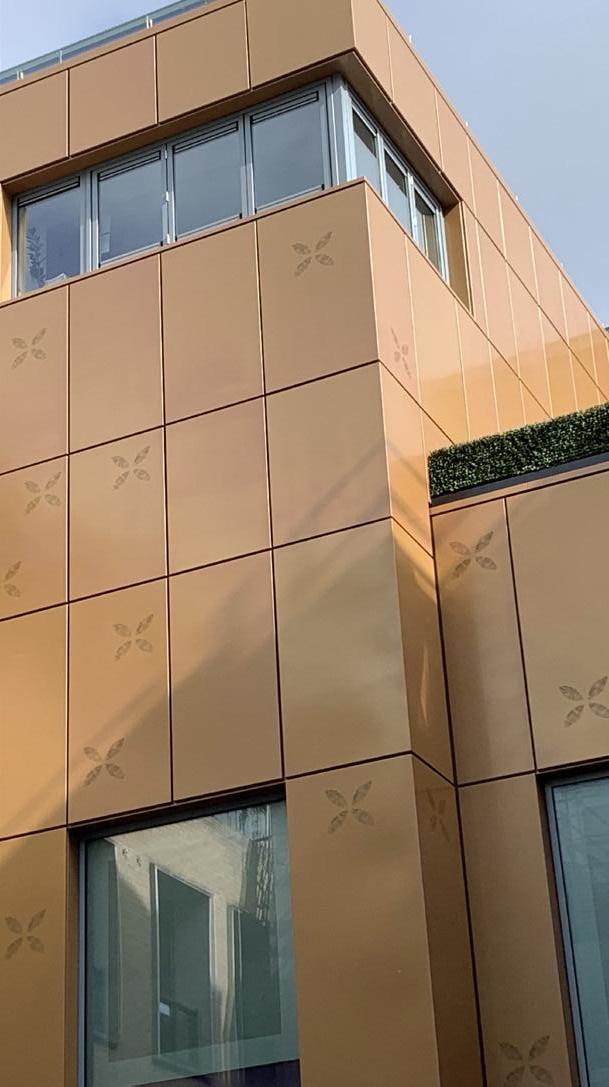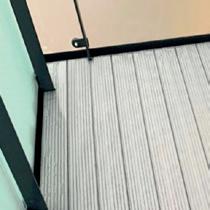
13 minute read
INDUSTRY UPDATES
N E W S IN BRIEF:
Advertisement
Stephen George + Partners LLP (SGP) has overseen the completion of the third and final phase of St. Modwen Park, Doncaster. Having masterplanned the whole 27-acre site, SGP successfully designed and delivered the last £7m phase, comprising more than 108,000ft 2 of industrial space, in February 2020. Working with St. Modwen and Lindum Construction, SGP designed the three units of 34,464ft 2 , 21,614ft 2 and 53,072ft 2 to complete the 247,000ft 2 development, which was granted outline consent in March 2016. SGP designed and delivered the first two phases of the park in 2016 and in 2017, and the speculative units were quickly occupied by Bosch Automotive, DB Schenker and Thornhill Engineering.
ASSAEL ARCHITECTURE WINS PLANNING PERMISSION
Connected Living London has been given the go-ahead for a new scheme at Southall Sidings, designed by awardwinning architect firm, Assael Architecture. The development at Southall Sidings, close to Southall station in the London Borough of Ealing, will provide 460 apartments designed and built specifically for rent. To meet the needs of London’s diverse population, 40% of the homes will be provided at a discounted market rent, whilst 48 three-bedroom homes will cater to families. Accommodated across a series of buildings, all of the new homes will sit alongside on-site resident amenities synonymous with the buildto-rent ethos, including a residents’ lounge, workspace and a gym, with the aim to cater to modern lifestyles while also creating a strong community within the development. The predominantly brick buildings have been contextually designed; four-storey courtyard buildings line Park Avenue to blend in with the existing built environment and enhance the public realm.
INDUSTRY UPDATES
FC&A ROUNDS UP THE LATEST INDUSTRY NEWS AND UPDATES.
PLANNING PERMISSION SECURED FOR CONSTRUCTION OF QUAD TWO BUILDING
Harwell Science and Innovation Campus has secured planning permission for Quad Two, a 47,000ft 2 Grade A development that will provide office space for science and technology companies at the UK’s major science hub in Oxfordshire.
HARWELL SCIENCE AND INNOVATION CAMPUS
The building has been designed to provide flexible office space so that three of the four floors can be let to single or multiple tenants in units ranging from 2500 to 20,000ft 2 . A roof terrace will allow occupiers to take advantage of the views across the carefully curated landscape of the campus and surrounding Area of Outstanding Natural Beauty. The main entrance includes a double-height reception and breakout space.
Quad Two is the third in a series of developments that will form a collegiate-style quadrangle alongside Harwell’s busy Becquerel Avenue where internationally renowned cutting-edge technology companies, such as Oxford Nanopore Technologies, Agilent and Oxford Space Systems, reside.
The Quad is already defined by a gym, cafe and the Quad One office building. The central Quad area, encircled by the buildings will be a beautifully landscaped public realm with a naturalistic planting character, which will play an important role in providing a comfortable central campus destination for meeting, socialising, and for one-off events.
The concept behind the unusual cladding treatment, a continuation of the Quad One building, was based on the core objective of sitting buildings comfortably inside the existing mature natural landscape by cleverly using light, reveal and scale. The facade is expressed through a pattern of repeating fins, and glazed, mirrored and solid panels that reflect and respond to the surrounding trees, grassland and riparian areas.
Angus Horner, Harwell Campus Director, said: “Harwell Campus is a world-leading home for fast growth science and
technology organisations. This new building will enable companies looking for a competitive, multi-cluster, collaborative advantage to be located alongside some of the brightest minds in the country, delivering worldleading research and lifechanging technologies.
“As demand for Grade A accommodation for ambitious science and tech companies has continued to grow across the UK, we are delighted to be able to meet this requirement in the form of Quad Two. With a total of 1.5 million sq ft to be developed, we look forward to welcoming many more people to Harwell in the coming years.”
Talking about their experience of establishing the UK’s Faraday Institution in Quad Two’s sibling building, Quad One, Susan Robertson, Chief Financial Officer and Joint Interim Chief

Executive Officer of The Faraday Institution, said: “New and better batteries are central to the UK’s ability to fully electrify. Establishing the HQ of the Faraday Institution in Quad One has enabled us to firmly place ourselves amongst the strong scientific community at Harwell and take advantage of co-location both with the central laboratory facilities that our battery research community uses extensively, and with other academic institutions, industry organisations and entrepreneurial spin outs that have also been attracted to this vibrant site.
“Our offices are spacious, well-maintained, and our team and visitors alike find them pleasant to work in.”
Oliver Milton, Partner at Hawkins\Brown, said: “Hawkins\ Brown are delighted that Quad Two has been granted planning permission. The building is the next step in the development of a series of buildings organised around a formal landscaped quad. It continues our involvement at Harwell Campus, which is one of the UK’s innovation hotspots.”
Catering for science and technology organisations at every stage of their growth, Quad Two will further expand Harwell’s unique portfolio of buildings. As well as being the UK headquarters for multinationals and fast growth SMEs, the 700-acre campus offers business incubation, free business service workshops, networking events and access to an onsite network of corporates, Government bodies and venture capital firms to collaborate with and access funding from.
N E W S IN BRIEF:
DMA WINS PLANNING IN THE HEART OF VICTORIA FOR BOUTIQUE HOTEL
Dexter Moren Associates (DMA) has won planning permission for a new, 137-key boutique lifestyle hotel on Vauxhall Bridge Road in the heart of Victoria. The hotel, featuring a unique facade design, will become the latest addition to client 4C Hotel Group’s growing portfolio of high-quality central London hotel developments. The eight-storey, 6224m 2 (GIA) hotel includes a relaxing bar, food retail, cafe and formal restaurant, available to the public as well as guests.
MACAULAY SINCLAIR APPOINTED TO LEADING UK PROJECT
Renowned interior architecture and design specialist Macaulay Sinclair has been appointed to create two stunning waterfront restaurants at The Island Quarter in Nottingham, the £650m regeneration scheme. Working nationally and internationally for wellknown hospitality brands, Macaulay Sinclair will be creating a stunning design for the three-storey pavilion building at Canal Turn – the first element of phase 1A. Macaulay Sinclair, which is also based in Nottingham, is well-known for creating interiors of big-name hospitality brands including Dishoom, Caravan and Hawksmoor. The company was chosen for The Island Quarter because of its “highly creative approach”, its understanding of this historical site – and vast industry knowledge and originality. Mike Sinclair, Co-Founder of Macaulay Sinclair, said: “Despite being based in Nottingham, the vast majority of our work is outside the area – and particularly in London. To be appointed to work on this prominent scheme right on our doorstep is hugely exciting for us.
ARCHITECT IN PROFILE
This month, we have talked to Hoban Design’s Director, Gary Hoban, about his experience opening his own architecture practice. In this exclusive Q&A, we find out more about what inspires his work and discover how childhood memories of LEGO and creative doodling steered the successful career he has today.
HOBAN DESIGN
GARY HOBAN
Director at Hoban Design

I M AG E : 1: Sutton Housing Society project 2: Sutton Housing Society project 3: Kylemore House 4: The Universita Luigi Bocconi
in Milan by Grafton Architects
Please tell us a bit about your career background. I am originally from Dublin and moved to London over 10 years ago. Initially, I worked in a practice in Dublin during the Celtic Tiger years, where the majority of our work was driven by large-scale developers, but the financial crash shelved nearly all the ambitious projects. I took this as an opportunity to move to London and broaden my horizons. I ventured into the field of high-end residential architecture in Central London. I thrived in this new sector where the shift of focus went from the macro to the micro. As a result, I built up a varying experience from site master planning to the intricate detailing of interior spaces.
Had you always wanted to pursue a career in architecture? Yes. From an early age, I adored LEGO. Coupled with my constant doodling which filled any spare space on my school copybooks, it led me to really have only one driving ambition; to become an architect. There is a joy common amongst all designers at any age of realising something conceived on paper into reality. Whether it is assembling a LEGO fire station, a piece of IKEA furniture or designing a building, it is this satisfaction that drives us.
Who has been your greatest influence and source of inspiration? I am actually not somebody who relies heavily on inspiration from other great architects. There are so many pioneers in architecture, and it can become a bit all-encompassing. Instead, I am fascinated about innovators from all walks of life, including Steve Jobs, Alan Turing and Stephen Hawking. Also, as a rugby fan, I was enthralled how the likes of Jonah Lomu and Brian O’Driscoll consistently performed at a level above others. Closer to home, I am also inspired

by the entrepreneurial journey of my own brother Robert, who has built up an exciting new proptech company, ‘Offr’, from the ground up.
What has been your most notable project to date? On a personal level, my first project as Hoban Design still makes me feel the proudest. It was the first time I ventured out and stood on my own two feet as an architect. Kylemore House was a large new-build home and it ended up winning two awards at the Evening Standard’s New Homes Awards.
How do you approach your projects? My main priority on any project is to exceed client expectations. Therefore, I don’t like to impose a particular ethos or try and influence a personal design agenda. It is vitally important to try and truly understand the goals and requirements from the client and then translate this into an architectural solution. Along the journey, we use our experience and knowledge to assist and advise how these goals could be best achieved.
What do you think is the greatest challenge for designing in sustainability? The greatest challenge is marrying a client’s expectations with the practical reality of good sustainable design. Many clients come to us with a project where the brief, budget and sustainability ambition are in direct conflict. It is then often the sustainability ambition that is sacrificed. As an example, we are working on a programme with Sutton Housing Society to expand their existing housing stock. The client has very honourable ambitions to integrate passive design strategies; however, there is an extremely limited opportunity as we are extending tired and dated buildings and must maintain occupancy for the existing residents during the build.

What is your favourite building and why? My favourite building changes almost daily! But today it is the Universita Luigi Bocconi in Milan by Grafton Architects. Yvonne Farrell, one of the Founders of Grafton Architects, was a tutor when I was studying Architecture at UCD (University College Dublin) and I have always greatly admired their achievements. As I am proud of my roots, I think Irish architects such as Grafton Architects have punched well above their weight and made a lasting impact on the international scene.
What do you think is the greatest challenge for architects today? A major challenge is educating society as to the role of an architect and their importance. There is an element of disconnect between the industry and society. Most simply don’t know what the profession entails, and many hold stereotypical views of what an architect does. In turn, the service is often undervalued and squeezed. This will make it more difficult to maintain a level of good design standards across the board and also dedicate time, energy and creativity to the development of integrating effective, sustainable design for the future.
What do you think is the greatest challenge for architecture students at the moment? At the moment, I clearly see the shift in the ‘work from home’ culture following the COVID-19 pandemic as being the biggest challenge. I think the best and most efficient space where architectural students can learn is in a collaborative environment with peers and mentors, whether that is in the university studio or within a practice. The social aspect is also an important factor, as ultimately, you must enjoy what you do to be successful as I always thrived in a sociable team environment. 2:

What advice would you give to newly qualified architects? Don’t be afraid to ask stupid questions! When you start out, it can be very intimidating. It may feel like you have to know everything from day one. Our world is filled with acronyms, industry terms and everchanging legislation. Nobody expects you to know everything. A career in architecture is a career in continuous questioning and learning.
What can we expect to see from Hoban Design over the next year? It is very difficult to predict. We have established ourselves as a practice specialising in high-end residential design. While this is an area we

thrive, it can be quite volatile. In the last few years, we have sought to bring our expertise to general housing needs. In 2018, we were appointed by social landlord Sutton Housing Society, and have recently secured planning permission for 71 new airspace homes. This has been a really rewarding, fresh challenge for our team and we now look forward to these projects commencing on site in 2021.
Moving forward, we see the ‘work from home’ culture boosting both of these areas, and we are already building up a new selection of private high-end residential projects, where work-life patterns are a much higher priority within the brief.


POWDERTECH COLLECTIONS NOW AVAILABLE THROUGH THE NBS NATIONAL BIM LIBRARY
Powdertech Corby’s unique ‘Collections’ range of powder coatings can now be researched and downloaded from the NBS National BIM Library.
This is the fastest-growing building information modelling (BIM) library in the UK, containing an extensive collection of both generic and manufacturer BIM objects ranging from building fabric systems to mechanical and electrical objects. All of the objects meet the requirements of the internationally-recognised NBS BIM Object Standard. Find more at https://source.thenbs.com and enter ‘Powdertech’ in the search box.
“We consider the NBS BIM library to be of huge benefit to architects, designers and building developers,” said Richard Besant, Director at Powdertech. “And, we wanted to be part of it. As users will know, the BIM library contains thousands of BIM objects which have
POWDERTECH CORBY
been authored and certified by NBS experts to the NBS BIM object standard, and this ensures the consistency and currency of all objects in the library.”
Users can access all of the coatings within the Powdertech Anomatch, Evolution, Landscape and PWF Collections. The benefits of each Collection are listed and associated technical data is provided. If users set up ‘My Library’, they can sort and filter favourite BIM objects. “Those involved in specifying products and services within the building industry are finding this such a useful tool, and we consider it very worthwhile to have our Collections on board,“ concluded Richard Besant.
NEW














